Cultural Capabilities and Safe Spaces: A Report for CUC107
VerifiedAdded on 2023/06/04
|10
|2773
|198
Report
AI Summary
This report analyzes cultural capabilities and intelligence, focusing on the creation of safe spaces within a workplace context. The assignment uses a clip from the TV series F.R.I.E.N.D.S to examine how characters demonstrate (or fail to demonstrate) effective cultural capabilities. The report begins with an executive summary, introduction, and observations drawn from the video. The core of the analysis delves into key concepts such as communication, cultural shock, changes in dynamics, body language, and cultural awareness, applying relevant theoretical frameworks. Recommendations are provided for improving cultural intelligence and fostering safer environments. The report concludes with a summary and conclusion, emphasizing the importance of cultural capabilities in professional settings. The assignment is a formal report submitted by a student on Desklib, a platform providing AI-powered study tools.
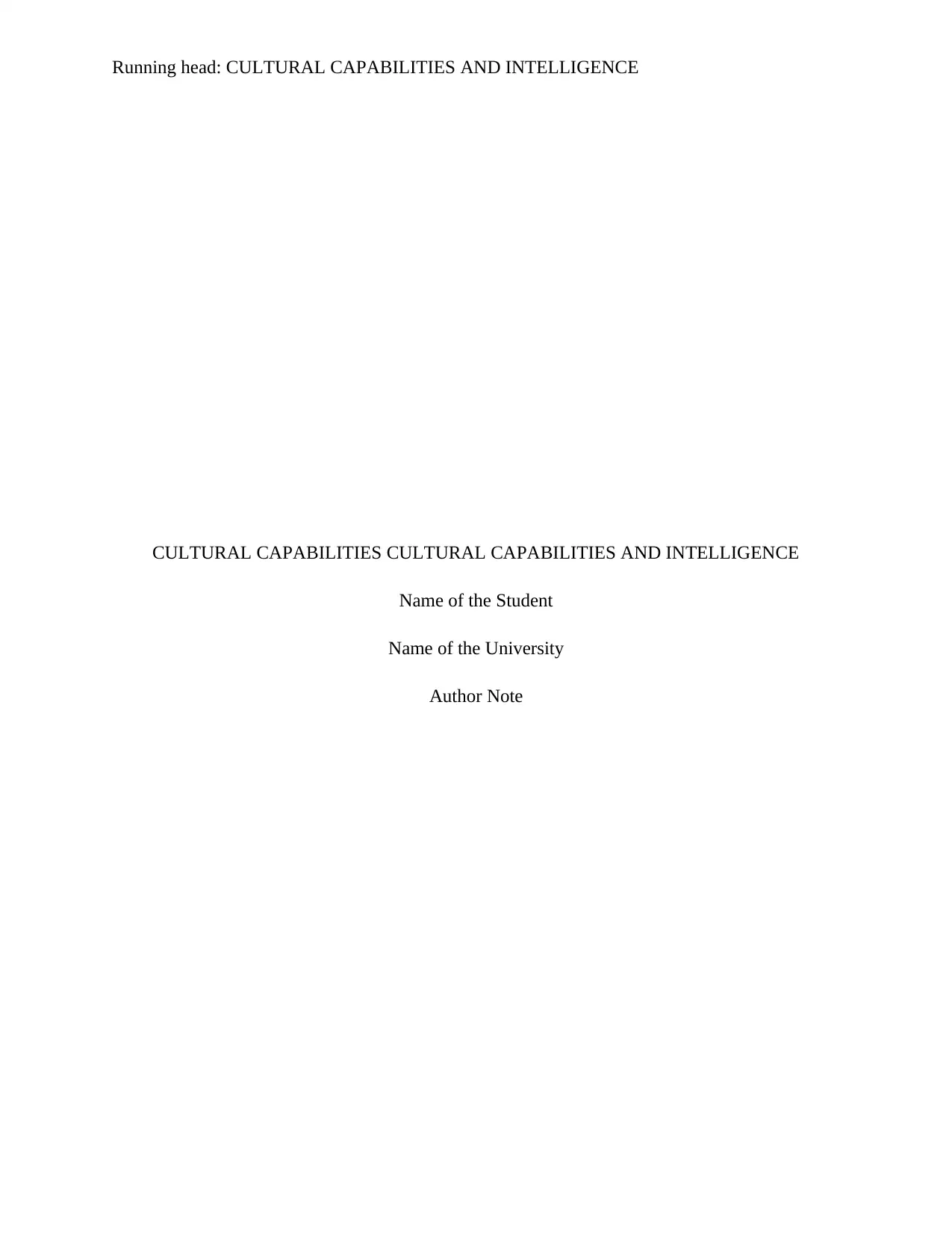
Running head: CULTURAL CAPABILITIES AND INTELLIGENCE
CULTURAL CAPABILITIES CULTURAL CAPABILITIES AND INTELLIGENCE
Name of the Student
Name of the University
Author Note
CULTURAL CAPABILITIES CULTURAL CAPABILITIES AND INTELLIGENCE
Name of the Student
Name of the University
Author Note
Paraphrase This Document
Need a fresh take? Get an instant paraphrase of this document with our AI Paraphraser
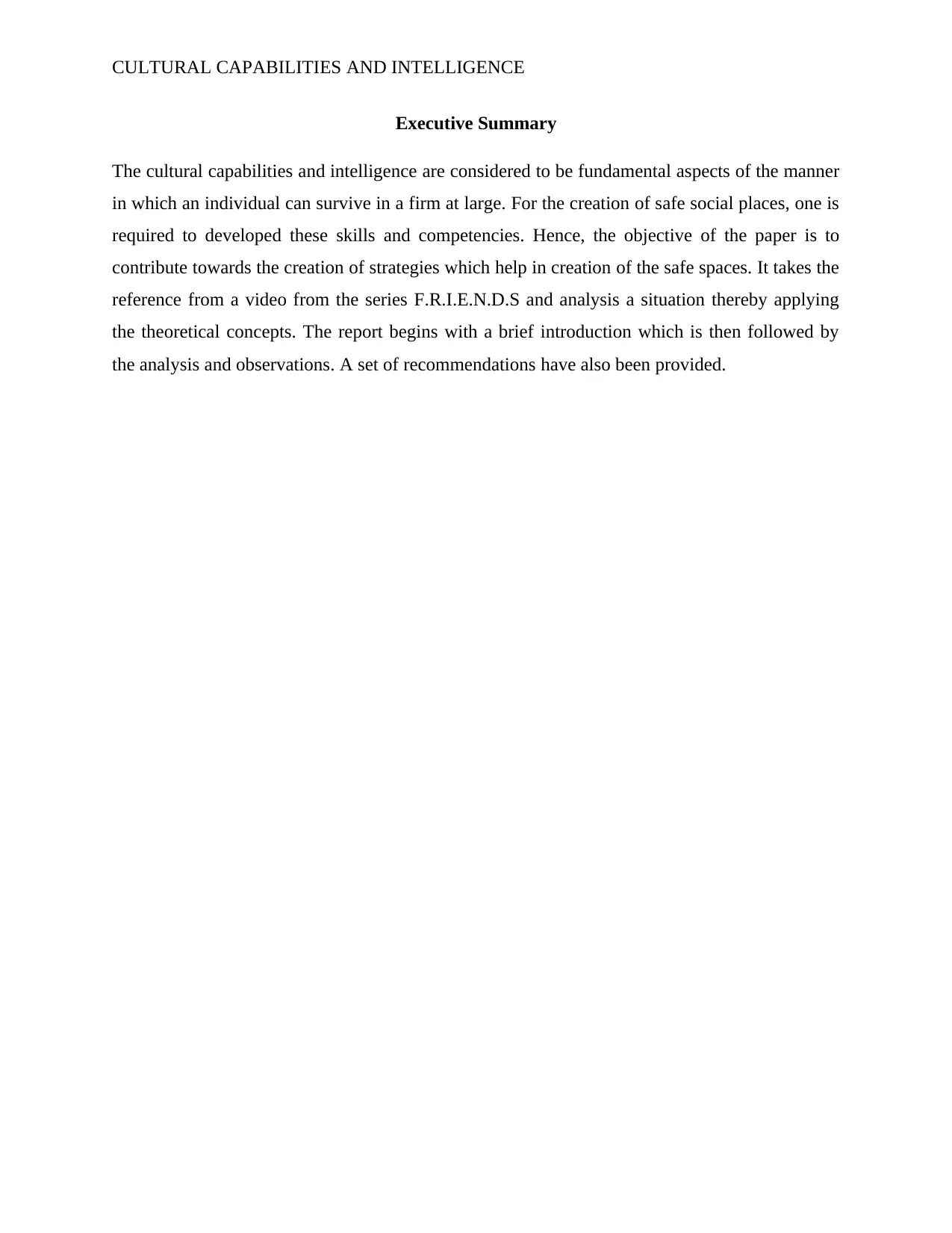
CULTURAL CAPABILITIES AND INTELLIGENCE
Executive Summary
The cultural capabilities and intelligence are considered to be fundamental aspects of the manner
in which an individual can survive in a firm at large. For the creation of safe social places, one is
required to developed these skills and competencies. Hence, the objective of the paper is to
contribute towards the creation of strategies which help in creation of the safe spaces. It takes the
reference from a video from the series F.R.I.E.N.D.S and analysis a situation thereby applying
the theoretical concepts. The report begins with a brief introduction which is then followed by
the analysis and observations. A set of recommendations have also been provided.
Executive Summary
The cultural capabilities and intelligence are considered to be fundamental aspects of the manner
in which an individual can survive in a firm at large. For the creation of safe social places, one is
required to developed these skills and competencies. Hence, the objective of the paper is to
contribute towards the creation of strategies which help in creation of the safe spaces. It takes the
reference from a video from the series F.R.I.E.N.D.S and analysis a situation thereby applying
the theoretical concepts. The report begins with a brief introduction which is then followed by
the analysis and observations. A set of recommendations have also been provided.
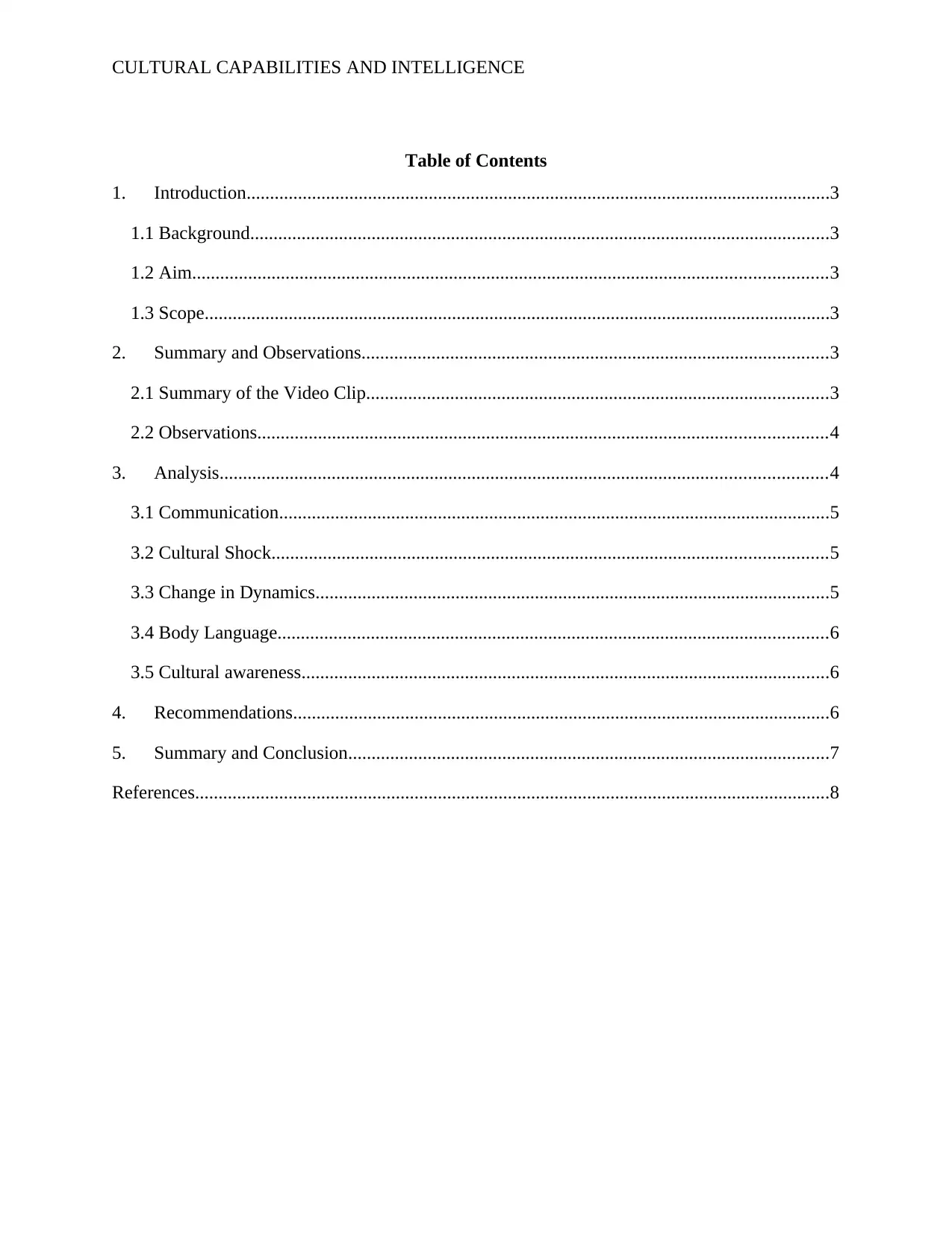
CULTURAL CAPABILITIES AND INTELLIGENCE
Table of Contents
1. Introduction.............................................................................................................................3
1.1 Background............................................................................................................................3
1.2 Aim........................................................................................................................................3
1.3 Scope......................................................................................................................................3
2. Summary and Observations....................................................................................................3
2.1 Summary of the Video Clip...................................................................................................3
2.2 Observations..........................................................................................................................4
3. Analysis..................................................................................................................................4
3.1 Communication......................................................................................................................5
3.2 Cultural Shock.......................................................................................................................5
3.3 Change in Dynamics..............................................................................................................5
3.4 Body Language......................................................................................................................6
3.5 Cultural awareness.................................................................................................................6
4. Recommendations...................................................................................................................6
5. Summary and Conclusion.......................................................................................................7
References........................................................................................................................................8
Table of Contents
1. Introduction.............................................................................................................................3
1.1 Background............................................................................................................................3
1.2 Aim........................................................................................................................................3
1.3 Scope......................................................................................................................................3
2. Summary and Observations....................................................................................................3
2.1 Summary of the Video Clip...................................................................................................3
2.2 Observations..........................................................................................................................4
3. Analysis..................................................................................................................................4
3.1 Communication......................................................................................................................5
3.2 Cultural Shock.......................................................................................................................5
3.3 Change in Dynamics..............................................................................................................5
3.4 Body Language......................................................................................................................6
3.5 Cultural awareness.................................................................................................................6
4. Recommendations...................................................................................................................6
5. Summary and Conclusion.......................................................................................................7
References........................................................................................................................................8
⊘ This is a preview!⊘
Do you want full access?
Subscribe today to unlock all pages.

Trusted by 1+ million students worldwide
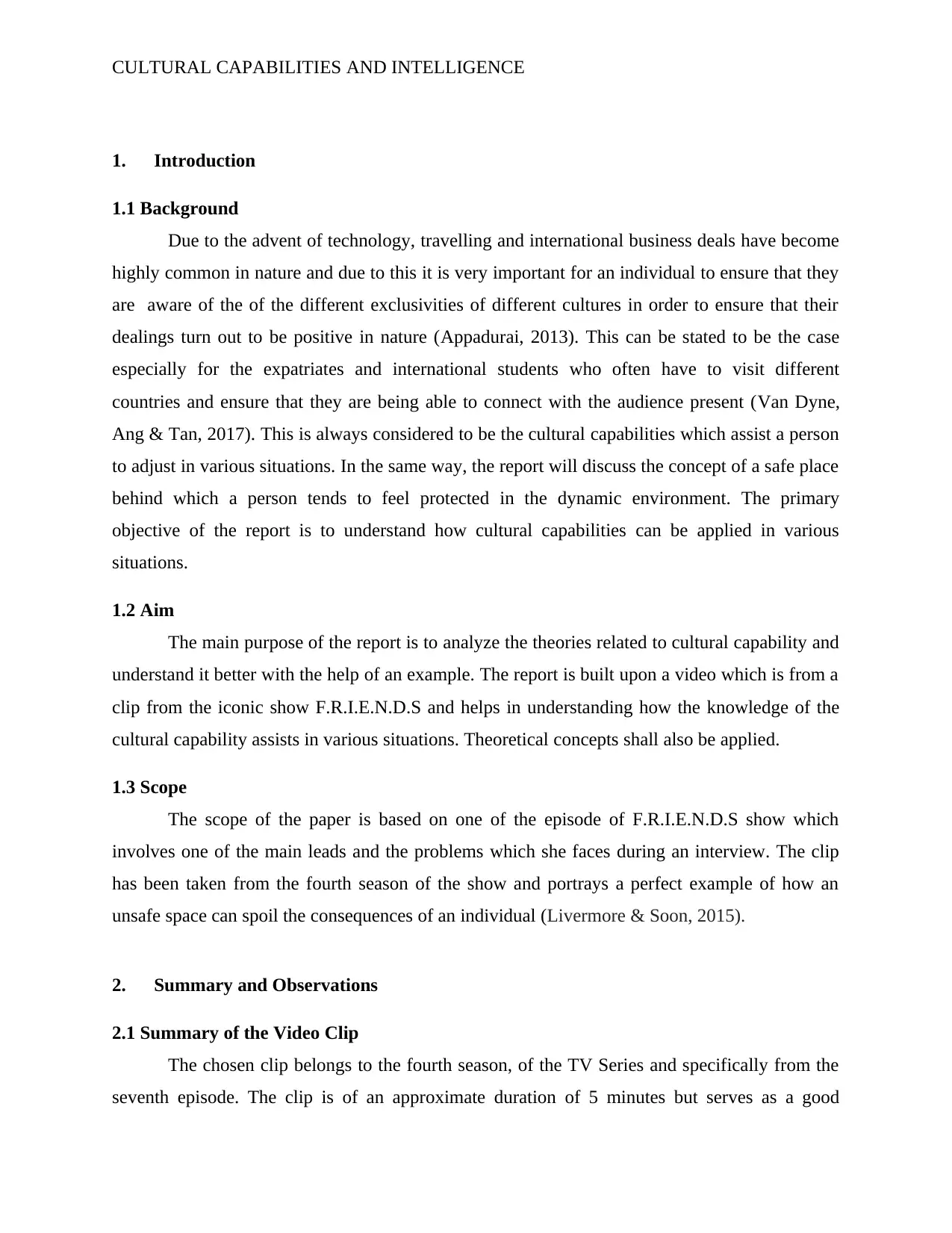
CULTURAL CAPABILITIES AND INTELLIGENCE
1. Introduction
1.1 Background
Due to the advent of technology, travelling and international business deals have become
highly common in nature and due to this it is very important for an individual to ensure that they
are aware of the of the different exclusivities of different cultures in order to ensure that their
dealings turn out to be positive in nature (Appadurai, 2013). This can be stated to be the case
especially for the expatriates and international students who often have to visit different
countries and ensure that they are being able to connect with the audience present (Van Dyne,
Ang & Tan, 2017). This is always considered to be the cultural capabilities which assist a person
to adjust in various situations. In the same way, the report will discuss the concept of a safe place
behind which a person tends to feel protected in the dynamic environment. The primary
objective of the report is to understand how cultural capabilities can be applied in various
situations.
1.2 Aim
The main purpose of the report is to analyze the theories related to cultural capability and
understand it better with the help of an example. The report is built upon a video which is from a
clip from the iconic show F.R.I.E.N.D.S and helps in understanding how the knowledge of the
cultural capability assists in various situations. Theoretical concepts shall also be applied.
1.3 Scope
The scope of the paper is based on one of the episode of F.R.I.E.N.D.S show which
involves one of the main leads and the problems which she faces during an interview. The clip
has been taken from the fourth season of the show and portrays a perfect example of how an
unsafe space can spoil the consequences of an individual (Livermore & Soon, 2015).
2. Summary and Observations
2.1 Summary of the Video Clip
The chosen clip belongs to the fourth season, of the TV Series and specifically from the
seventh episode. The clip is of an approximate duration of 5 minutes but serves as a good
1. Introduction
1.1 Background
Due to the advent of technology, travelling and international business deals have become
highly common in nature and due to this it is very important for an individual to ensure that they
are aware of the of the different exclusivities of different cultures in order to ensure that their
dealings turn out to be positive in nature (Appadurai, 2013). This can be stated to be the case
especially for the expatriates and international students who often have to visit different
countries and ensure that they are being able to connect with the audience present (Van Dyne,
Ang & Tan, 2017). This is always considered to be the cultural capabilities which assist a person
to adjust in various situations. In the same way, the report will discuss the concept of a safe place
behind which a person tends to feel protected in the dynamic environment. The primary
objective of the report is to understand how cultural capabilities can be applied in various
situations.
1.2 Aim
The main purpose of the report is to analyze the theories related to cultural capability and
understand it better with the help of an example. The report is built upon a video which is from a
clip from the iconic show F.R.I.E.N.D.S and helps in understanding how the knowledge of the
cultural capability assists in various situations. Theoretical concepts shall also be applied.
1.3 Scope
The scope of the paper is based on one of the episode of F.R.I.E.N.D.S show which
involves one of the main leads and the problems which she faces during an interview. The clip
has been taken from the fourth season of the show and portrays a perfect example of how an
unsafe space can spoil the consequences of an individual (Livermore & Soon, 2015).
2. Summary and Observations
2.1 Summary of the Video Clip
The chosen clip belongs to the fourth season, of the TV Series and specifically from the
seventh episode. The clip is of an approximate duration of 5 minutes but serves as a good
Paraphrase This Document
Need a fresh take? Get an instant paraphrase of this document with our AI Paraphraser
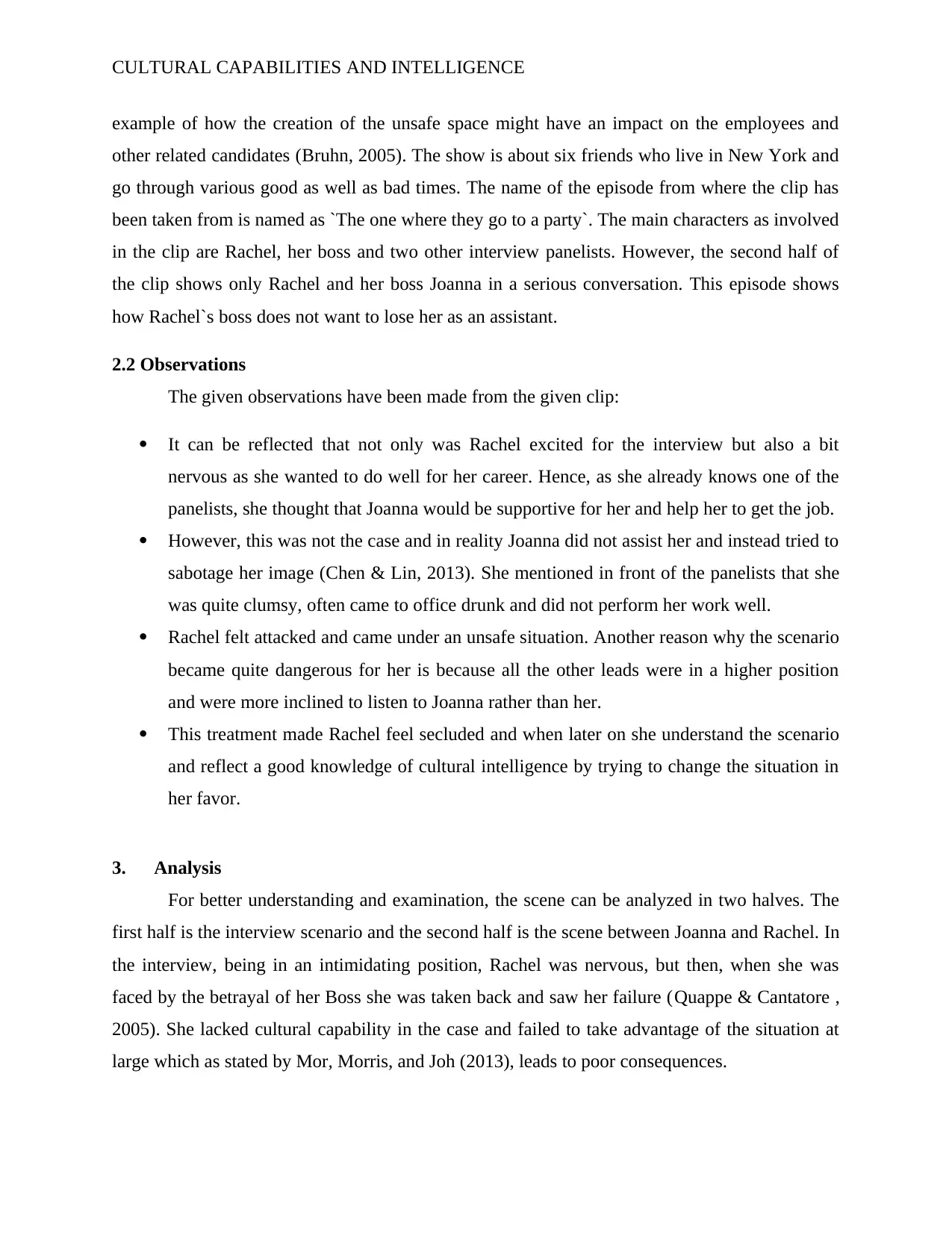
CULTURAL CAPABILITIES AND INTELLIGENCE
example of how the creation of the unsafe space might have an impact on the employees and
other related candidates (Bruhn, 2005). The show is about six friends who live in New York and
go through various good as well as bad times. The name of the episode from where the clip has
been taken from is named as `The one where they go to a party`. The main characters as involved
in the clip are Rachel, her boss and two other interview panelists. However, the second half of
the clip shows only Rachel and her boss Joanna in a serious conversation. This episode shows
how Rachel`s boss does not want to lose her as an assistant.
2.2 Observations
The given observations have been made from the given clip:
It can be reflected that not only was Rachel excited for the interview but also a bit
nervous as she wanted to do well for her career. Hence, as she already knows one of the
panelists, she thought that Joanna would be supportive for her and help her to get the job.
However, this was not the case and in reality Joanna did not assist her and instead tried to
sabotage her image (Chen & Lin, 2013). She mentioned in front of the panelists that she
was quite clumsy, often came to office drunk and did not perform her work well.
Rachel felt attacked and came under an unsafe situation. Another reason why the scenario
became quite dangerous for her is because all the other leads were in a higher position
and were more inclined to listen to Joanna rather than her.
This treatment made Rachel feel secluded and when later on she understand the scenario
and reflect a good knowledge of cultural intelligence by trying to change the situation in
her favor.
3. Analysis
For better understanding and examination, the scene can be analyzed in two halves. The
first half is the interview scenario and the second half is the scene between Joanna and Rachel. In
the interview, being in an intimidating position, Rachel was nervous, but then, when she was
faced by the betrayal of her Boss she was taken back and saw her failure (Quappe & Cantatore ,
2005). She lacked cultural capability in the case and failed to take advantage of the situation at
large which as stated by Mor, Morris, and Joh (2013), leads to poor consequences.
example of how the creation of the unsafe space might have an impact on the employees and
other related candidates (Bruhn, 2005). The show is about six friends who live in New York and
go through various good as well as bad times. The name of the episode from where the clip has
been taken from is named as `The one where they go to a party`. The main characters as involved
in the clip are Rachel, her boss and two other interview panelists. However, the second half of
the clip shows only Rachel and her boss Joanna in a serious conversation. This episode shows
how Rachel`s boss does not want to lose her as an assistant.
2.2 Observations
The given observations have been made from the given clip:
It can be reflected that not only was Rachel excited for the interview but also a bit
nervous as she wanted to do well for her career. Hence, as she already knows one of the
panelists, she thought that Joanna would be supportive for her and help her to get the job.
However, this was not the case and in reality Joanna did not assist her and instead tried to
sabotage her image (Chen & Lin, 2013). She mentioned in front of the panelists that she
was quite clumsy, often came to office drunk and did not perform her work well.
Rachel felt attacked and came under an unsafe situation. Another reason why the scenario
became quite dangerous for her is because all the other leads were in a higher position
and were more inclined to listen to Joanna rather than her.
This treatment made Rachel feel secluded and when later on she understand the scenario
and reflect a good knowledge of cultural intelligence by trying to change the situation in
her favor.
3. Analysis
For better understanding and examination, the scene can be analyzed in two halves. The
first half is the interview scenario and the second half is the scene between Joanna and Rachel. In
the interview, being in an intimidating position, Rachel was nervous, but then, when she was
faced by the betrayal of her Boss she was taken back and saw her failure (Quappe & Cantatore ,
2005). She lacked cultural capability in the case and failed to take advantage of the situation at
large which as stated by Mor, Morris, and Joh (2013), leads to poor consequences.
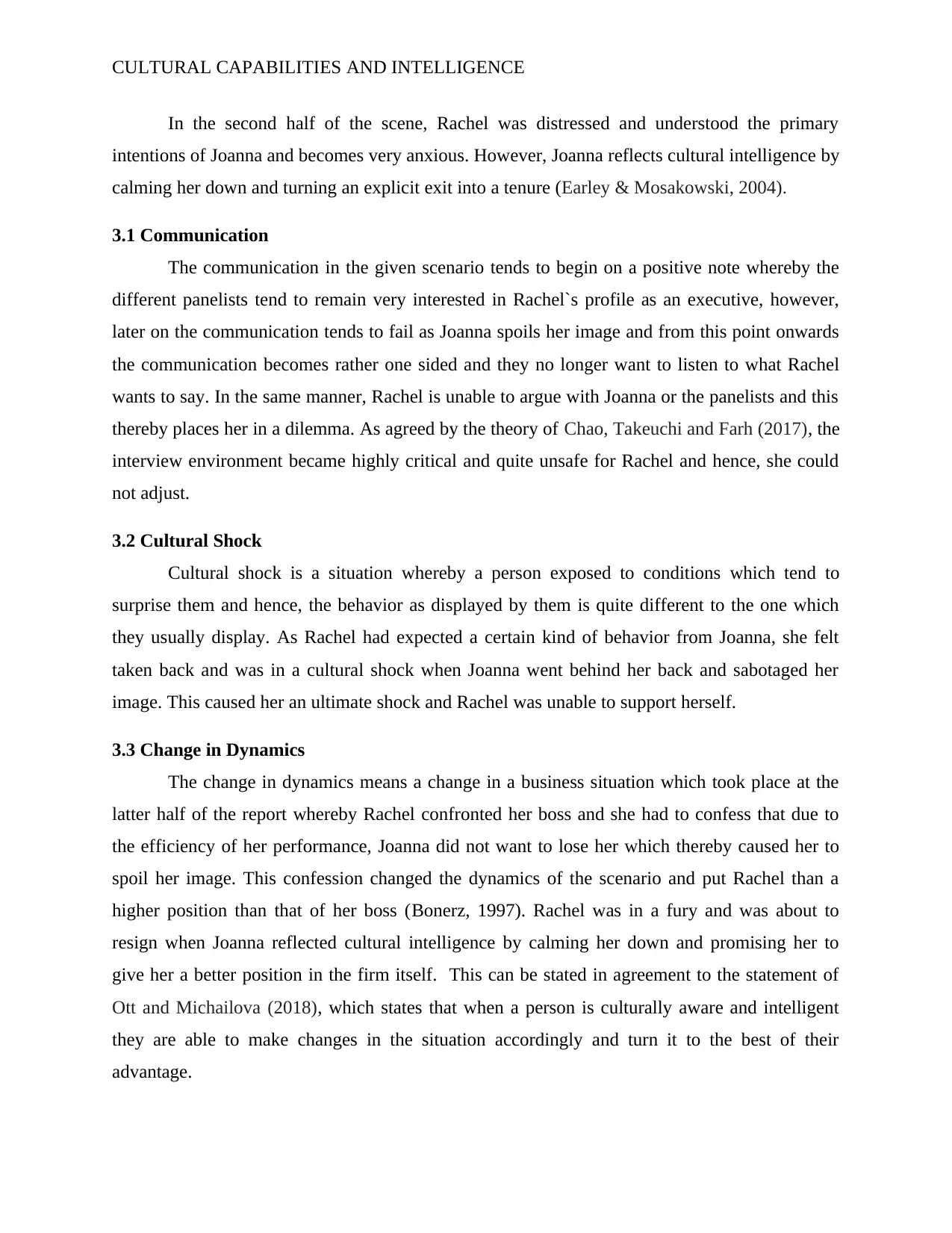
CULTURAL CAPABILITIES AND INTELLIGENCE
In the second half of the scene, Rachel was distressed and understood the primary
intentions of Joanna and becomes very anxious. However, Joanna reflects cultural intelligence by
calming her down and turning an explicit exit into a tenure (Earley & Mosakowski, 2004).
3.1 Communication
The communication in the given scenario tends to begin on a positive note whereby the
different panelists tend to remain very interested in Rachel`s profile as an executive, however,
later on the communication tends to fail as Joanna spoils her image and from this point onwards
the communication becomes rather one sided and they no longer want to listen to what Rachel
wants to say. In the same manner, Rachel is unable to argue with Joanna or the panelists and this
thereby places her in a dilemma. As agreed by the theory of Chao, Takeuchi and Farh (2017), the
interview environment became highly critical and quite unsafe for Rachel and hence, she could
not adjust.
3.2 Cultural Shock
Cultural shock is a situation whereby a person exposed to conditions which tend to
surprise them and hence, the behavior as displayed by them is quite different to the one which
they usually display. As Rachel had expected a certain kind of behavior from Joanna, she felt
taken back and was in a cultural shock when Joanna went behind her back and sabotaged her
image. This caused her an ultimate shock and Rachel was unable to support herself.
3.3 Change in Dynamics
The change in dynamics means a change in a business situation which took place at the
latter half of the report whereby Rachel confronted her boss and she had to confess that due to
the efficiency of her performance, Joanna did not want to lose her which thereby caused her to
spoil her image. This confession changed the dynamics of the scenario and put Rachel than a
higher position than that of her boss (Bonerz, 1997). Rachel was in a fury and was about to
resign when Joanna reflected cultural intelligence by calming her down and promising her to
give her a better position in the firm itself. This can be stated in agreement to the statement of
Ott and Michailova (2018), which states that when a person is culturally aware and intelligent
they are able to make changes in the situation accordingly and turn it to the best of their
advantage.
In the second half of the scene, Rachel was distressed and understood the primary
intentions of Joanna and becomes very anxious. However, Joanna reflects cultural intelligence by
calming her down and turning an explicit exit into a tenure (Earley & Mosakowski, 2004).
3.1 Communication
The communication in the given scenario tends to begin on a positive note whereby the
different panelists tend to remain very interested in Rachel`s profile as an executive, however,
later on the communication tends to fail as Joanna spoils her image and from this point onwards
the communication becomes rather one sided and they no longer want to listen to what Rachel
wants to say. In the same manner, Rachel is unable to argue with Joanna or the panelists and this
thereby places her in a dilemma. As agreed by the theory of Chao, Takeuchi and Farh (2017), the
interview environment became highly critical and quite unsafe for Rachel and hence, she could
not adjust.
3.2 Cultural Shock
Cultural shock is a situation whereby a person exposed to conditions which tend to
surprise them and hence, the behavior as displayed by them is quite different to the one which
they usually display. As Rachel had expected a certain kind of behavior from Joanna, she felt
taken back and was in a cultural shock when Joanna went behind her back and sabotaged her
image. This caused her an ultimate shock and Rachel was unable to support herself.
3.3 Change in Dynamics
The change in dynamics means a change in a business situation which took place at the
latter half of the report whereby Rachel confronted her boss and she had to confess that due to
the efficiency of her performance, Joanna did not want to lose her which thereby caused her to
spoil her image. This confession changed the dynamics of the scenario and put Rachel than a
higher position than that of her boss (Bonerz, 1997). Rachel was in a fury and was about to
resign when Joanna reflected cultural intelligence by calming her down and promising her to
give her a better position in the firm itself. This can be stated in agreement to the statement of
Ott and Michailova (2018), which states that when a person is culturally aware and intelligent
they are able to make changes in the situation accordingly and turn it to the best of their
advantage.
⊘ This is a preview!⊘
Do you want full access?
Subscribe today to unlock all pages.

Trusted by 1+ million students worldwide

CULTURAL CAPABILITIES AND INTELLIGENCE
3.4 Body Language
When the situation was against Rachel in the first half of the video clip, it was reflected
that her body language was quite nervous and that her hands were clasped and she was being
dominated and harassed by the allegations of her boss. Her body language reflected what she was
actually feeling inside and due to this, the interviews did not believe her case. The second half of
the act shows her in a dominating position whereby she was appalled by her boss`s backstab.
Here Joanna`s body language, has changed and she seems to be pleading to Rachel as to request
her not to leave (Holley & Steiner, 2005). Her body language reflects her state of mind where
she is scared of losing out on a potential employee like Rachel.
3.5 Cultural awareness
In the entire video clip, it needs to be mentioned, that Joanna was the only character who
reflects cultural awareness of the different surroundings. In the interview round, Joanna
understood the points whereby they would not like Rachel and also understood how to
manipulate the situation in her favor. She came to the conclusion that if she had to retain Rachel
in the firm she would be required to sabotage her image and hence, she did that. Her capabilities
reflected in her manipulative behavior and her understanding of the different situations and
scenario. Even in the second half of the scene, she knew that she was required to ensure that
Rachel had to be calmed down and had to be given a lucrative offer which would make her stay
in the firm for a longer time frame. According to Brislin, Worthley and Macnab (2006), when an
individual is able to take advantage of any situation, it reflects true cultural capability as well as
intelligence.
4. Recommendations
Hence, it would be right to state that when a person is not able to handle a particular
situation adequately, they might be made to feel in an unsafe situation whereby they feel exposed
and uncomfortable which results in a future loss for them in the long run (Russell, 2011). In the
given video of the television series, Joanna in the beginning showed awareness of the interview
ethics and procedure and disrespected Rachel which then led to the panel rejection for Rachel.
This aspect greatly upset Rachel who was unable to stand for herself and it shows that how
Rachel was unable to portray cultural capability (Erez et al., 2013). Had Rachel been a bit more
3.4 Body Language
When the situation was against Rachel in the first half of the video clip, it was reflected
that her body language was quite nervous and that her hands were clasped and she was being
dominated and harassed by the allegations of her boss. Her body language reflected what she was
actually feeling inside and due to this, the interviews did not believe her case. The second half of
the act shows her in a dominating position whereby she was appalled by her boss`s backstab.
Here Joanna`s body language, has changed and she seems to be pleading to Rachel as to request
her not to leave (Holley & Steiner, 2005). Her body language reflects her state of mind where
she is scared of losing out on a potential employee like Rachel.
3.5 Cultural awareness
In the entire video clip, it needs to be mentioned, that Joanna was the only character who
reflects cultural awareness of the different surroundings. In the interview round, Joanna
understood the points whereby they would not like Rachel and also understood how to
manipulate the situation in her favor. She came to the conclusion that if she had to retain Rachel
in the firm she would be required to sabotage her image and hence, she did that. Her capabilities
reflected in her manipulative behavior and her understanding of the different situations and
scenario. Even in the second half of the scene, she knew that she was required to ensure that
Rachel had to be calmed down and had to be given a lucrative offer which would make her stay
in the firm for a longer time frame. According to Brislin, Worthley and Macnab (2006), when an
individual is able to take advantage of any situation, it reflects true cultural capability as well as
intelligence.
4. Recommendations
Hence, it would be right to state that when a person is not able to handle a particular
situation adequately, they might be made to feel in an unsafe situation whereby they feel exposed
and uncomfortable which results in a future loss for them in the long run (Russell, 2011). In the
given video of the television series, Joanna in the beginning showed awareness of the interview
ethics and procedure and disrespected Rachel which then led to the panel rejection for Rachel.
This aspect greatly upset Rachel who was unable to stand for herself and it shows that how
Rachel was unable to portray cultural capability (Erez et al., 2013). Had Rachel been a bit more
Paraphrase This Document
Need a fresh take? Get an instant paraphrase of this document with our AI Paraphraser
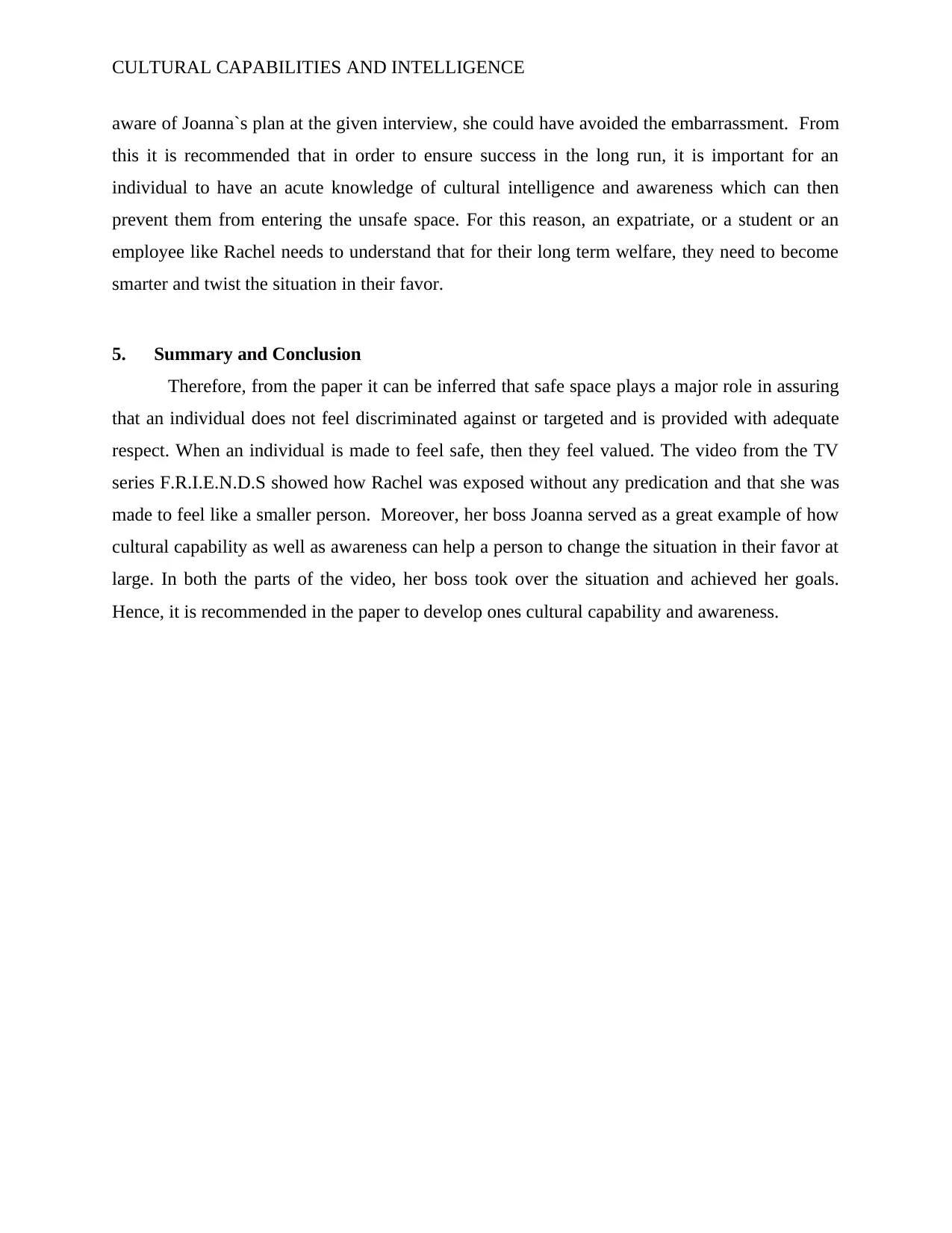
CULTURAL CAPABILITIES AND INTELLIGENCE
aware of Joanna`s plan at the given interview, she could have avoided the embarrassment. From
this it is recommended that in order to ensure success in the long run, it is important for an
individual to have an acute knowledge of cultural intelligence and awareness which can then
prevent them from entering the unsafe space. For this reason, an expatriate, or a student or an
employee like Rachel needs to understand that for their long term welfare, they need to become
smarter and twist the situation in their favor.
5. Summary and Conclusion
Therefore, from the paper it can be inferred that safe space plays a major role in assuring
that an individual does not feel discriminated against or targeted and is provided with adequate
respect. When an individual is made to feel safe, then they feel valued. The video from the TV
series F.R.I.E.N.D.S showed how Rachel was exposed without any predication and that she was
made to feel like a smaller person. Moreover, her boss Joanna served as a great example of how
cultural capability as well as awareness can help a person to change the situation in their favor at
large. In both the parts of the video, her boss took over the situation and achieved her goals.
Hence, it is recommended in the paper to develop ones cultural capability and awareness.
aware of Joanna`s plan at the given interview, she could have avoided the embarrassment. From
this it is recommended that in order to ensure success in the long run, it is important for an
individual to have an acute knowledge of cultural intelligence and awareness which can then
prevent them from entering the unsafe space. For this reason, an expatriate, or a student or an
employee like Rachel needs to understand that for their long term welfare, they need to become
smarter and twist the situation in their favor.
5. Summary and Conclusion
Therefore, from the paper it can be inferred that safe space plays a major role in assuring
that an individual does not feel discriminated against or targeted and is provided with adequate
respect. When an individual is made to feel safe, then they feel valued. The video from the TV
series F.R.I.E.N.D.S showed how Rachel was exposed without any predication and that she was
made to feel like a smaller person. Moreover, her boss Joanna served as a great example of how
cultural capability as well as awareness can help a person to change the situation in their favor at
large. In both the parts of the video, her boss took over the situation and achieved her goals.
Hence, it is recommended in the paper to develop ones cultural capability and awareness.
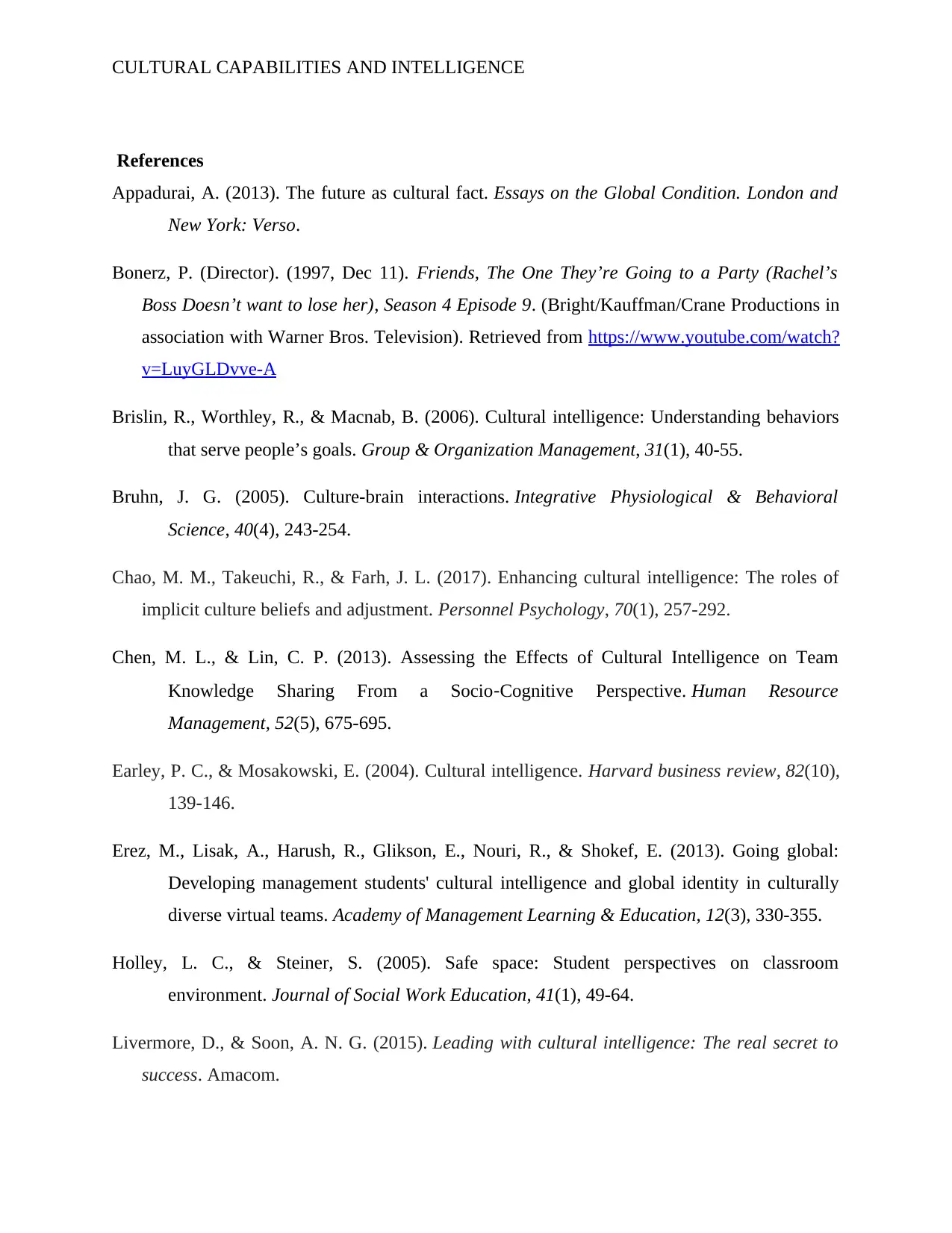
CULTURAL CAPABILITIES AND INTELLIGENCE
References
Appadurai, A. (2013). The future as cultural fact. Essays on the Global Condition. London and
New York: Verso.
Bonerz, P. (Director). (1997, Dec 11). Friends, The One They’re Going to a Party (Rachel’s
Boss Doesn’t want to lose her), Season 4 Episode 9. (Bright/Kauffman/Crane Productions in
association with Warner Bros. Television). Retrieved from https://www.youtube.com/watch?
v=LuyGLDvve-A
Brislin, R., Worthley, R., & Macnab, B. (2006). Cultural intelligence: Understanding behaviors
that serve people’s goals. Group & Organization Management, 31(1), 40-55.
Bruhn, J. G. (2005). Culture-brain interactions. Integrative Physiological & Behavioral
Science, 40(4), 243-254.
Chao, M. M., Takeuchi, R., & Farh, J. L. (2017). Enhancing cultural intelligence: The roles of
implicit culture beliefs and adjustment. Personnel Psychology, 70(1), 257-292.
Chen, M. L., & Lin, C. P. (2013). Assessing the Effects of Cultural Intelligence on Team
Knowledge Sharing From a Socio‐Cognitive Perspective. Human Resource
Management, 52(5), 675-695.
Earley, P. C., & Mosakowski, E. (2004). Cultural intelligence. Harvard business review, 82(10),
139-146.
Erez, M., Lisak, A., Harush, R., Glikson, E., Nouri, R., & Shokef, E. (2013). Going global:
Developing management students' cultural intelligence and global identity in culturally
diverse virtual teams. Academy of Management Learning & Education, 12(3), 330-355.
Holley, L. C., & Steiner, S. (2005). Safe space: Student perspectives on classroom
environment. Journal of Social Work Education, 41(1), 49-64.
Livermore, D., & Soon, A. N. G. (2015). Leading with cultural intelligence: The real secret to
success. Amacom.
References
Appadurai, A. (2013). The future as cultural fact. Essays on the Global Condition. London and
New York: Verso.
Bonerz, P. (Director). (1997, Dec 11). Friends, The One They’re Going to a Party (Rachel’s
Boss Doesn’t want to lose her), Season 4 Episode 9. (Bright/Kauffman/Crane Productions in
association with Warner Bros. Television). Retrieved from https://www.youtube.com/watch?
v=LuyGLDvve-A
Brislin, R., Worthley, R., & Macnab, B. (2006). Cultural intelligence: Understanding behaviors
that serve people’s goals. Group & Organization Management, 31(1), 40-55.
Bruhn, J. G. (2005). Culture-brain interactions. Integrative Physiological & Behavioral
Science, 40(4), 243-254.
Chao, M. M., Takeuchi, R., & Farh, J. L. (2017). Enhancing cultural intelligence: The roles of
implicit culture beliefs and adjustment. Personnel Psychology, 70(1), 257-292.
Chen, M. L., & Lin, C. P. (2013). Assessing the Effects of Cultural Intelligence on Team
Knowledge Sharing From a Socio‐Cognitive Perspective. Human Resource
Management, 52(5), 675-695.
Earley, P. C., & Mosakowski, E. (2004). Cultural intelligence. Harvard business review, 82(10),
139-146.
Erez, M., Lisak, A., Harush, R., Glikson, E., Nouri, R., & Shokef, E. (2013). Going global:
Developing management students' cultural intelligence and global identity in culturally
diverse virtual teams. Academy of Management Learning & Education, 12(3), 330-355.
Holley, L. C., & Steiner, S. (2005). Safe space: Student perspectives on classroom
environment. Journal of Social Work Education, 41(1), 49-64.
Livermore, D., & Soon, A. N. G. (2015). Leading with cultural intelligence: The real secret to
success. Amacom.
⊘ This is a preview!⊘
Do you want full access?
Subscribe today to unlock all pages.

Trusted by 1+ million students worldwide
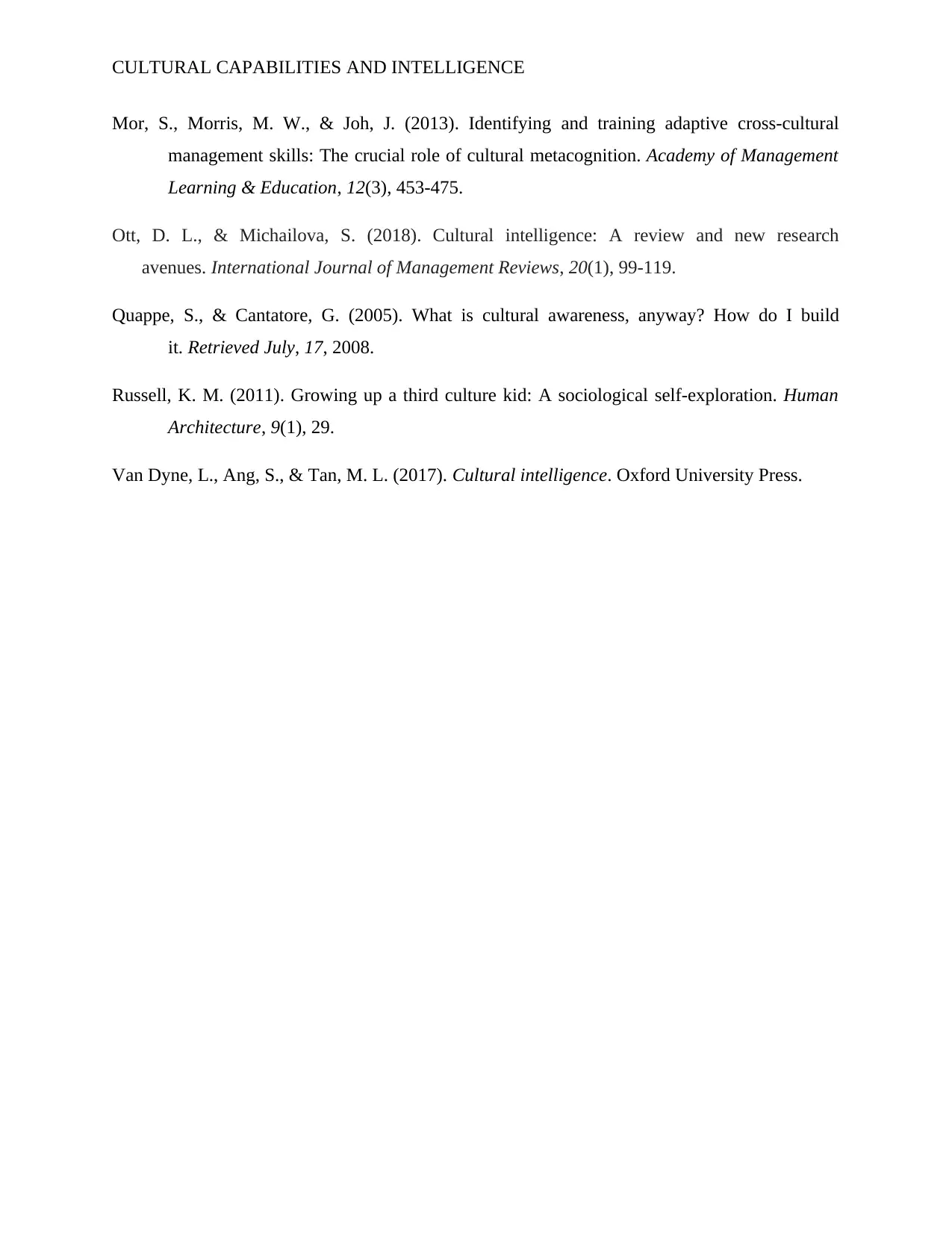
CULTURAL CAPABILITIES AND INTELLIGENCE
Mor, S., Morris, M. W., & Joh, J. (2013). Identifying and training adaptive cross-cultural
management skills: The crucial role of cultural metacognition. Academy of Management
Learning & Education, 12(3), 453-475.
Ott, D. L., & Michailova, S. (2018). Cultural intelligence: A review and new research
avenues. International Journal of Management Reviews, 20(1), 99-119.
Quappe, S., & Cantatore, G. (2005). What is cultural awareness, anyway? How do I build
it. Retrieved July, 17, 2008.
Russell, K. M. (2011). Growing up a third culture kid: A sociological self-exploration. Human
Architecture, 9(1), 29.
Van Dyne, L., Ang, S., & Tan, M. L. (2017). Cultural intelligence. Oxford University Press.
Mor, S., Morris, M. W., & Joh, J. (2013). Identifying and training adaptive cross-cultural
management skills: The crucial role of cultural metacognition. Academy of Management
Learning & Education, 12(3), 453-475.
Ott, D. L., & Michailova, S. (2018). Cultural intelligence: A review and new research
avenues. International Journal of Management Reviews, 20(1), 99-119.
Quappe, S., & Cantatore, G. (2005). What is cultural awareness, anyway? How do I build
it. Retrieved July, 17, 2008.
Russell, K. M. (2011). Growing up a third culture kid: A sociological self-exploration. Human
Architecture, 9(1), 29.
Van Dyne, L., Ang, S., & Tan, M. L. (2017). Cultural intelligence. Oxford University Press.
1 out of 10